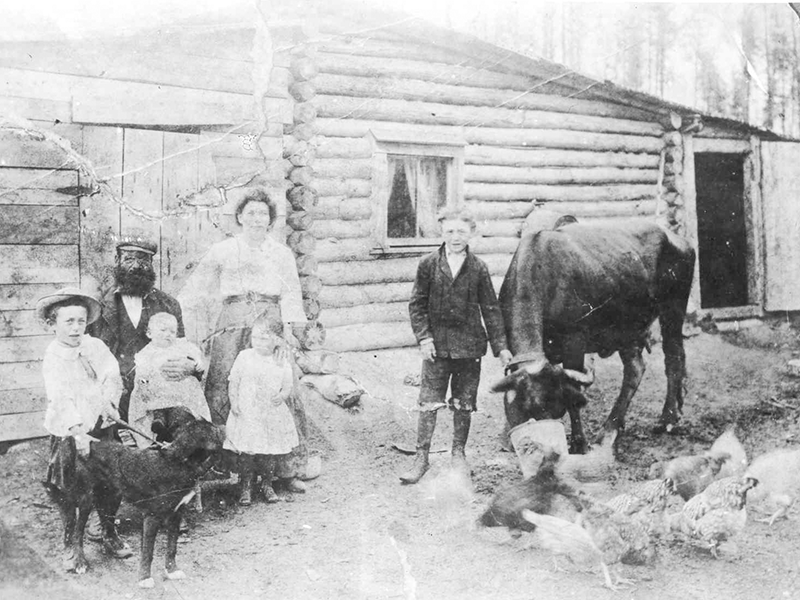A small photographic exhibit in the main-floor gallery of the Miles Nadal JCC at Bloor and Spadina tells the small but interesting story of Jewish farming in Ontario, past and present.
The story of Jews tilling the soil is “definitely peripheral” to the usual Jewish immigrant narrative in Ontario, says Dara Solomon, executive director of the Ontario Jewish Archives Blankenstein Family Heritage Centre, which sponsored the exhibit with the Jewish environmental organization Shoresh. Jews are more usually regarded “as an urban people, toiling away in the garment district,” she notes.
A remarkable early photo, dating from 1912, shows the Gurevitch family on their farm in the northern community of Krugendorf, where there was a Baron de Hirsch-sponsored Jewish farming community like those in Manitoba and Saskatchewan. Recent arrivals from the Pale of Settlement, the Gurevitches stand with their children, some chickens and a cow in front of a neatly hewn log building.
Mendel Silbert left Lithuania in 1905 to avoid conscription in the Russian-Japanese war. After several false starts, he operated a farm in Wentworth, near Hamilton. A 1919 photograph shows him pitching hay from a wagon with his son Alex.
READ: HISTORY OF TORONTO’S YIDDISH THEATRE ON DISPLAY
Several photos relate to the Canadian Jewish Farm School, operated by Jewish “back to the land” advocate Morris Saxe, who sought to resettle Jewish immigrants in Canada, especially in the 1920s. The photo “Harvesting hay, CJFS, 1928” shows a group of farm workers with pitchforks, posed all around and on top of a horse-driven hay wagon.
“We have a lot of photos from the Canadian Jewish Farm School,” Solomon said. “Many of them of them are posed photos, clearly taken for publicity.”
Several photos relate to a remarkable group of friends that arrived here from Czechoslovakia in 1938 to operate a dairy farm they purchased in Mount Hope, south of Hamilton, having convinced the authorities that they were all farm workers and having committed themselves to the venture for at least five years.
“Though conditions were difficult – adapting to the cold, learning English, making a living – some of these refugees continued to farm after the five years,” the caption explains.
Indeed, the Loewith family turned the enterprise into a large and successful business. A photo shows Dave and Carl Loewith with a newborn calf in 1980, when they were named Wentworth County Farmers of the Year. Today, more than 500 baby calves are delivered on their farm every year.
Several late-1940s photographs highlight Hechalutz (pioneer) farms. The Hechalutz Hamizrachi training farm, for example, was a 168-acre enterprise in Guelph that offered a one-year intensive agricultural program to prepare young men and women spiritually and physically for pioneer life in Israel.
Other photos focus on various family enterprises such as the Love-Smith family farm. Details about the two women in that particular photo, who are sitting on a car’s bumper in front of a barn, remained unknown until Bunny Bergstein, a 92-year-old volunteer at the archives, recognized them as his cousins.
Three panels depicting recent Shoresh activities give the exhibit a contemporary edge. One of the organization’s goals is “to build a Jewish community that is connected to the outdoors,” says Sabrina Malach, Shoresh’s director for community engagement.
Among other activities, Shoresh volunteers have built a set of beehives on its recently inaugurated Bela Farm in Hillsburgh.
“Our main products so far have been education and honey,” Malach said. “We sold 1,000 jars of honey for Rosh Hashanah.”
The Untold Past and Present of Jewish Farming in Ontario opened Oct. 6 and runs until Oct. 30. A public reception is scheduled for Thursday Oct. 20, 5 to 7 p.m. For more details, please visit www.ontariojewisharchives.org or http://shoresh.ca/.
